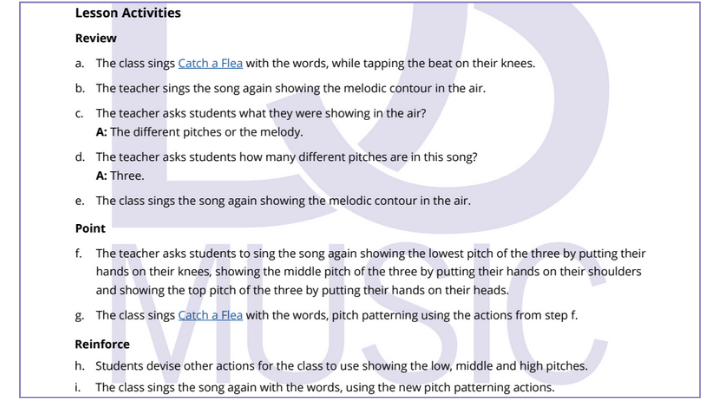Why Kodály-inspired teaching is vital for sequential music learning
Comments Off on Why Kodály-inspired teaching is vital for sequential music learningWhen teaching sequential music learning, long term strategic planning is essential.
The first step is deciding what should be included in your curriculum, then, determining the sequence in which these should be taught and when.
Once the overall sequence has been determined, a teaching strategy is developed for each element or concept based on the Three Ps: Prepare, Present and Practice, ensuring step-by-step learning for students.

Three P’s: Prepare
Preparation is the most detailed section of a strategy and is divided into Aural Preparation and Visual Preparation steps.
For example, the Preparation steps for a Rhythmic Strategy, should include the following steps in order:

1. Learn repertoire (only includes known elements plus the new element).
Aural Preparation:
2. Sing this repertoire while performing the rhythm, hearing the beat and rhythm simultaneously and performing the beat and rhythm simultaneously
3. Aurally discover that there is a new rhythmic element
4. Aurally discover where the new rhythmic element is
5. Aurally discover everything new about the new rhythmic element
Visual Preparation:
6. Learn what the new rhythmic element looks like.
Keen on exploring this more for melodic elements? Click here.
Three P’s: Present & Practice
After preparation is Present / Make Conscious, the shortest and least crucial step of the Three P’s, simply where the new element is named and linked together with its sound & symbol.
Last in the sequence is the Practice segment of a teaching Strategy, which includes a list of at least 12 activities designed to practice, internalise and consolidate the knowledge acquired in the Prepare and Present steps.
The 12 activities should include at least four activities for each Practice Stage: Early, Mid and Late in order of level of difficulty, with approximately three of each Practice Type: Aural, Visual, Written and Creative activities, although there’s much more available in the practice space in the Music Teacher’s Digital Library (MTDL!)
Teaching Strategy: Sequential Teaching
& Learning Time-Savers!
In Kodály-inspired teaching, we use terms like strategy outline, teaching strategy (mentioned above) and teaching focus across our curriculum and planning material.
What do we mean by ‘teaching strategy?’
A Teaching Strategy is the detailed plan for teaching a musical concept/element.
It includes step-by-step directions for the teacher and sometimes the actual wording or script that contains the questions and specific directions for students.

Teaching Strategy Outlines
In the outline itself then, the teaching strategy is shown through three main areas.
Objectives/Outcomes/Learning Intentions, which acts as a short summary of what the students will be able to do by the completion of the strategy.
Prerequisite skills/knowledge, or a list all the rhythmic and melodic skills and knowledge that the students already understand.
Plus a Song List for Teaching, containing only the element to be taught and elements already known.
Following these three sections, each teaching strategy carefully sequences Prepare (Discovery), Present (Naming) and ongoing Practice of a concept.
Teaching Focus: Lessons for Sequential Learning

This sort of teaching focus layout is educator directed and well-planned to capture student attention and interest and to ensure true learning and understanding occurs.
When done well, a teaching focus is taking what students know (review), quickly guiding them to the new information (point), and then immediately consolidating that (reinforce) before moving on.
We can see here that students aren’t reviewing everything they know about an element, just what is relevant to the Point section itself. That’s the shortest part of the teaching focus sequence, before ‘Reinforce‘, in order to ensure the new information has been understood.
And remember…
This is just some of the planning and support information and material that exists in the Music Teacher’s Digital Library (MTDL) for you to teach in this Kodály-inspired way to get your students really knowing!
Happy sequential teaching & learning, everyone! – Deb


Comments are closed